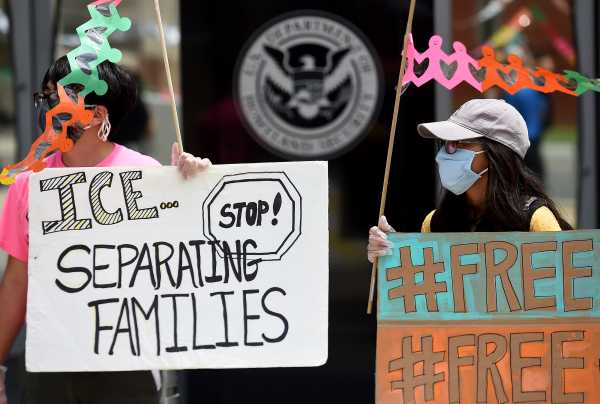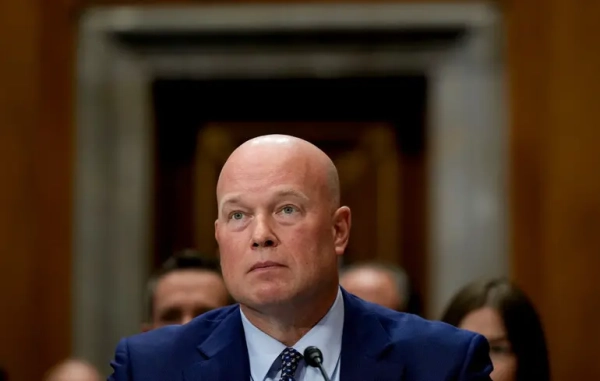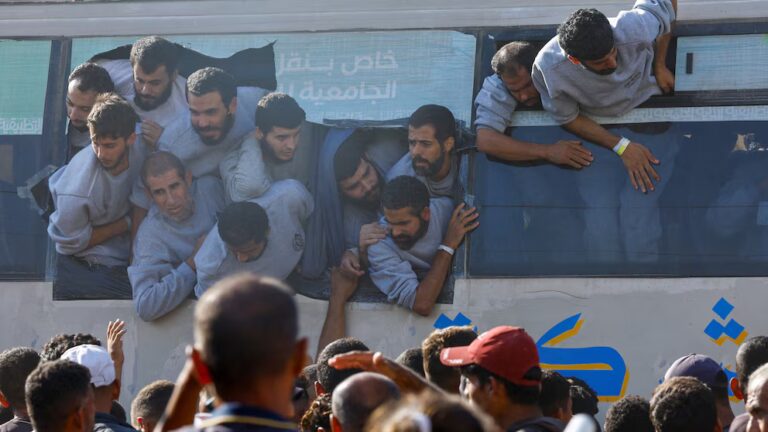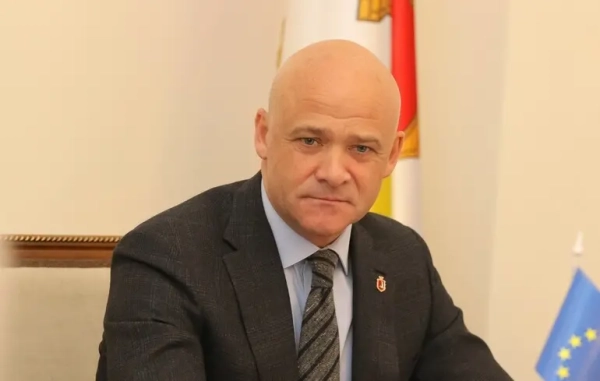
President Donald Trump made a pledge in June 2018 to stop separating families in immigration detention, seemingly bringing an end to a policy that was designed to deter migrants from attempting to cross the southern border, and that ignited protests nationwide.
“We’re going to keep families together but we still have to maintain toughness or our country will be overrun by people, by crime, by all of the things that we don’t stand for and that we don’t want,” Trump said, signing an executive order stating that it is the “policy of this administration to maintain family unity” in immigration detention except in cases where parents pose a danger to their children.
But two years later, it’s clear that the Trump administration never fully renounced family separations.
Immigrant advocates found that hundreds of children were separated from their parents and other family members in the months following Trump’s executive order. In at least some cases, immigration officials were using minor immigration violations, such as reentering the US without authorization, and unsubstantiated allegations of gang affiliation, to claim that parents posed a danger to their children and to justify separating them.
These kinds of separations have largely come to a halt, particularly as the Trump administration has shut down the asylum system at the southern border in recent months.
Now, amid the Covid-19 pandemic, the administration is setting itself up to carry out what immigrant advocates call a new kind of family separation. This time, it’s pressuring parents already detained within the United States to voluntarily separate from their children by presenting them with what the administration has called a “binary choice.” Either allow their children to be placed with relatives or a foster family in the US while the parents remain detained, or stay together as a family in indefinite detention and risk contracting Covid-19.
This risk for these families isn’t theoretical: Covid-19 has already spread through ICE facilities and in the prison system more broadly, infecting thousands who are in confinement.
The policy affects about 300 parents and children who remain detained across three family detention centers, two in Texas and one in Pennsylvania, where they are housed together.
But in presenting this choice, the administration is ignoring a third option: releasing the families together, which it has the discretion to do at any time. Under previous administrations, many families were simply released into the interior of the US on parole if the parents had no criminal history.
“We know that there is an alternative,” Krish Vignarajah, president and CEO of Lutheran Immigration and Refugee Services, said. “We hope that this moment should force us to ask ourselves why we lock up asylum-seeking families in the first place. Unless the families are released together, we are looking at family separation by another name.”
ICE has been ordered to release children, but that could lead to family separations
The coronavirus has already ripped through immigration detention centers: Across the more than 130 private and state-run facilities nationwide, there have been more than 3,800 confirmed Covid-19 cases and three deaths among detainees as of Tuesday.
US Immigration and Customs Enforcement has released some medically vulnerable people from immigration detention during the pandemic. It has also made efforts to mitigate the spread of coronavirus in its facilities; for instance, it recently instituted voluntary Covid-19 testing for new arrivals at one of the family detention centers in Karnes, Texas, and started isolating people who test positive so they don’t infect other detainees.
But ICE’s compliance with Covid-19 preventative protocols has remained spotty. Across the three family detention centers, about 90 staff and detainees have consequently contracted the virus so far.
Last month, a federal judge in California found that the conditions inside these detention centers remain hazardous, ruling that keeping children in detention likely violates a decades-old agreement that lays out basic standards for their care. That agreement — known as the “Flores settlement” — mandates that the government release migrant children “without unnecessary delay” and keep them in “safe and sanitary conditions” in the meantime.
Children themselves don’t generally appear to be vulnerable to the virus unless they have a preexisting health condition that puts them at risk. But the effects of social isolation in detention can be particularly harmful to them, exacerbating psychological trauma and mental health issues during a critical developmental period. They may also be able to carry the virus without exhibiting symptoms, potentially spreading it to those with whom they come into contact.
The judge consequently ordered the government to release more than 100 children.
“The family residential centers are on fire and there is no more time for half measures,” US District Judge Dolly Gee wrote in her decision.
ICE was supposed to comply with that order by July 27. But the agency is required to obtain parents’ consent in order to release their children to relatives or foster families in the US, and none have agreed so far.
What’s more, the agency remains steadfast in refusing to release the families together or pursue comparatively low-cost alternatives to keeping immigrants in detention, including the now-defunct Obama-era Family Case Management Program. Under that program, which Trump ended in June 2017, families were released and assigned to social workers who aided them in finding attorneys and accommodation and ensured that they showed up for their court hearings.
Judge Gee acknowledged Saturday that her earlier order to release the children is essentially “unenforceable” until the status quo changes. She can’t compel ICE to release the parents along with their children as part of the lawsuit she’s overseeing. And another federal judge in Washington, DC, who has jurisdiction over the parents’ cases, recently refused to release them despite finding that ICE “continues to fall short of full compliance” with its Covid-19 guidelines.
Lawyers for the immigrants are still trying to negotiate with the Trump administration over a permanent procedure by which ICE could present parents with the option of allowing their children to be released or else waive their children’s right to be expediently released under the Flores settlement. They’re asking the government to at least offer an explanation of immigrants’ rights.
But some immigrant advocates say those negotiations shouldn’t be happening in the first place and that the lawyers should instead be seeking the release of all families. RAICES, an organization that offers legal aid to immigrants and refugees, is trying to intervene in the case before Judge Gee.
“Both permanent separation and indefinite detention are adverse to their interests,” the organization said in a statement. “The very act of presenting families in prison together with this question is cruel.”
In the meantime, families have to weigh the trade-offs: potentially exposing their children to the coronavirus in these detention facilities versus a traumatic separation that could also put their well-being at risk.
ICE has been pursuing this binary choice policy since the early days of the pandemic, though it has yet to persuade any families in detention to voluntarily separate. A report by Amnesty International found that officials at all three family detention centers had instructed immigrant parents as early as mid-May to sign forms that would allow their children to be released from detention.
The forms were written in English, which many of the Spanish-speaking and Indigenous immigrants could not understand. NBC News’s Julia Ainsley, who obtained a copy of the forms, reported that the form stated that it complied with the Flores settlement agreement.
The parents were told that their children would be sent to the custody of the Department of Health and Human Services Office of Refugee Resettlement, which could place them with other family members in the US or foster families, according to Refugees International. Some children were under the age of 3, including 12-month-old babies who could not yet talk or walk.
The parents knew that, if they remained in detention without their children, they would face almost certain deportation. But they also feared for their children as the coronavirus continued to spread in immigration detention.
“They didn’t force us, but they did tell us we could send our daughter away because of the pandemic,” one parent said in the Amnesty International report.
Family separations were previously used to deter unauthorized immigrants
The Trump administration previously separated parents from their children as the consequence of a “zero-tolerance” policy meant to deter immigrants from attempting to cross the border without authorization. Beginning in mid-2017, the federal government ran a pilot program in El Paso, Texas, under which it began filing criminal charges against anyone who crossed the border without authorization, including parents with minor children — even though many of them intended to seek asylum in the US.
Parents were sent to immigration detention to await deportation proceedings. Their children, meanwhile, were sent to separate facilities operated by ORR and, in some cases, released to other family members in the US or foster homes.
The Trump administration formalized the policy in May 2018. At least 5,000 families were separated before Judge Gee ordered the federal government in June 2018 to reunify the families affected and end the policy.
The federal government, however, neglected to link the children to their parents in its databases, making the reunification process difficult, especially in the hundreds of cases of children who were under the age of 5.
Advocates say that the Trump administration is now trying to use family separations as a way to make it easier to deport parents. The Los Angeles Times’ Molly O’Toole detailed one such case in which officials threatened to deport a couple’s children back to El Salvador alone unless their mother gives up her claims to protection in the US and goes back with them, promising never to return to the US.
Family separations carry a long-term cost
The US government has long known the psychological harms associated with separating families. These harms would only add to the anxiety created by the pandemic as immigrants and their children fight for their release from detention.
Commander Jonathan White, who previously oversaw the government’s program providing care to unaccompanied immigrant children, told Congress that, beginning in February 2017, he had repeatedly warned the officials who concocted the policy that it would likely cause “significant potential for traumatic psychological injury to the child.”
A September 2019 government watchdog report confirmed those effects, finding that immigrant children who entered government custody in 2018 frequently experienced “intense trauma” and those who were “unexpectedly separated from a parent” even more so.
Each child reacts to family separation differently. But psychologists have observed three main kinds of effects: disruptions to their social attachments, increases in their emotional vulnerability, and, in some cases, post-traumatic stress disorder, Lauren Fasig Caldwell, director of the American Psychological Association’s children, youth, and families office, said.
Those symptoms could be only short-term or persist in the long run — or not even manifest until a child enters their teen years or adulthood. Any of them could significantly hinder a child’s later success in academics and in the workplace.
Parents who were separated from their children have experienced their own trauma — which may manifest in symptoms similar to those that researchers observe in children — and may not have the mental and emotional capacity to be able to provide what their children need.
“This crisis is certainly a crisis of the government’s own making,” Shalyn Fluharty, director of the Dilley Pro Bono Project, a legal aid group for women and children seeking asylum, said in a press call in May. “No parent should be presented with a choice of being separated from their child.”
Support Vox’s explanatory journalism
Every day at Vox, we aim to answer your most important questions and provide you, and our audience around the world, with information that has the power to save lives. Our mission has never been more vital than it is in this moment: to empower you through understanding. Vox’s work is reaching more people than ever, but our distinctive brand of explanatory journalism takes resources — particularly during a pandemic and an economic downturn. Your financial contribution will not constitute a donation, but it will enable our staff to continue to offer free articles, videos, and podcasts at the quality and volume that this moment requires. Please consider making a contribution to Vox today.
Sourse: vox.com






